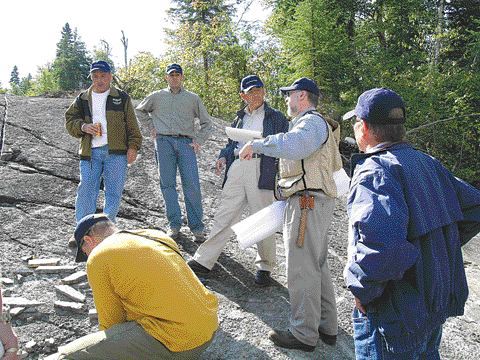A preliminary economic assessment of the Marathon copper-palladium-platinum deposit in the Coldwell intrusive complex near Marathon, Ont., shows an open-pit mine could be profitable at recent metal prices.
The study, commissioned by Marathon PGM (MAR-V, MRPGF-O) and prepared by P&E Mining Consultants, showed an internal rate of return of 21% using 18-month averages for metal prices and the Canadian/U.S. dollar exchange rate. A discounted cash flow analysis, using a 7% discount rate, put the net present value of the project at $156 million.
The 18-month averages were US$234 per oz. for palladium, US$949 per oz. for platinum, US$485 per oz. for gold, and US$4,255 per tonne (US$1.93 per lb.) for copper. The Canadian dollar averaged US84 during the same period.
Using those averages to calculate a gross-value cutoff grade also increased the size of the Marathon deposit’s measured and indicated resource, to 49.3 million tonnes grading 0.31% copper, 0.91 gram palladium, 0.24 gram platinum and 0.09 gram gold per tonne. A resource estimate announced in February calculated the measured and indicated resource at 40 million tonnes, with average grades of 0.36% copper, 1.07 grams palladium, 0.29 gram platinum and 0.1 gram gold per tonne.
The inferred resource also expanded, to 8.7 million tonnes averaging 0.29% copper, 0.92 gram palladium, 0.28 gram platinum and 0.11 gram gold, from 4.6 million tonnes grading 0.31% copper, 1.06 grams palladium, 0.33 gram platinum and 0.12 gram gold per tonne.
The resources are all inside a conceptual open-pit outline. Most of the mineralized zones are still open at depth or along strike.
The expansion in the resource came from using a cutoff gross value of $7.56 (Canadian) per tonne at the 18-month trailing average of market prices for the four metals. The February resource calculation had used 2-year averages for the same metal prices, and set the cutoff gross value at $12 per tonne.
What differed between scoping study and resource calculation was the planned scale of the operation; the scoping study used an 18,000-tonne-per-day milling rate, up from 12,000 tonnes in the resource calculation, which brought bulk mining costs down. That, in turn, meant a lower value could be used to cut off the size of the resource.
The proposed mine would produce an average 195,000 oz. of precious metals — about three-quarters of it palladium — and 17,000 tonnes copper annually for the first four years of production. The pit would have a life of just over nine years, and the first four years would pay back the capital costs. Those were estimated at $248 million, with all equipment owned rather than leased.
The study pegged cash production costs at US$91 per oz. of precious metals, over the life of the mine. In the 4-year payback period, costs would be around US$88 per oz.
Obviously, when recent high metal prices are plugged into the spreadsheet, the economics of the operation improve substantially. At 12-month averages for the prices of the same four metals — US$255 per oz. for palladium, US$993 for platinum, US$513 for gold and US$4,740 per tonne (US$2.15 per lb.) for copper, the project’s internal rate of return rises to 27% and its net present value to $231 million.
Ten-year averages of US$328 per oz. for palladium, US$587 for platinum, US$345 for gold and US$2,250 per tonne (US$1.20 per lb.) for copper bring the rate of return down to 10% and the net present value to $33 million, but probably reflect a time of unusually depressed metal prices.
Marathon has a 20,000-metre drill program under way to expand the resource, and plans metallurgical testing, on P&E’s recommendation, to see if nickel, silver and rhodium, all present in the mineralization, can be recovered. The study assumed the use of a conventional flotation mill to produce a bulk copper concentrate also containing the precious metals.
Meanwhile, drilling at the Dunlop property, immediately south of the Marathon resource, has intersected wide zones of low-grade copper and silver mineralization.
Marathon’s program, an early stage drilling campaign of 13 holes, tested an induced-polarization anomaly on the property. The holes were drilled in two east-west “fence” patterns across the anomaly, which coincides with a breccia zone on the contact between a gabbro and older volcanic and sedimentary rocks.
The mineralization consists of disseminated sulphides and occupies zones from 60 to 200 metres wide. Copper grades mainly average 0.1% to 0.2% across the whole width of the zone, although there are local high-grade intervals in the drill cores. They also contain between 1 and 3 grams silver per tonne.
Unlike the Marathon deposit, there are negligible platinum group elements in this mineralization. Marathon geologists are assuming the two deposits are unrelated.
Marathon bought the property last March from well-known Manitoba prospector Bruce Dunlop, who received $250,000 and retains a 3% net smelter return. The ground straddles Highway 17, just east of the Marathon townsite, and is surrounded by staked ground held by Marathon.
T.N.M. Nugget
MARATHON PROJECT
OWNERSHIP
Marathon PGM
RESOURCE
49 Mt, 0.31% copper, 0.91 g/t palladium, 0.24 g/t platinum, 0.09 g/t gold
MINE
Open pit
PLANT
Conventional flotation, 18,000 tonnes/day, producing bulk copper concentrate with precious metals
CAPITAL COST
$248 million, including 15% contingency
PRODUCTION COST
US$88/oz for precious metals
ECONOMICS
IRR 21%, NPV $156M (discount rate 7%)


Be the first to comment on "Preliminary economics on Marathon positive (July 17, 2006)"